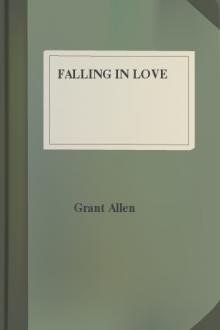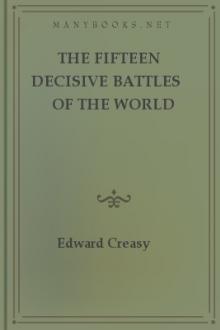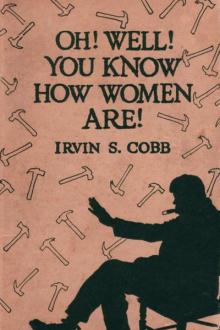Falling in Love by Grant Allen (different e readers .txt) 📕

- Author: Grant Allen
- Performer: -
Book online «Falling in Love by Grant Allen (different e readers .txt) 📕». Author Grant Allen
In order to understand it one ought to examine a coco-nut in the act of budding, and to do this it is by no means necessary to visit the West Indies or the Pacific Islands; all you need to do is to ask a Covent Garden fruit salesman to get you a few 'growers.' On the voyage to England, a certain number of precocious coco-nuts, stimulated by the congenial warmth and damp of most shipholds, usually begin to sprout before their time; and these waste nuts are sold by the dealers at a low rate to East-end children and inquiring botanists. An examination of a 'grower' very soon convinces one what is the use of the milk in the coco-nut.
It must be duly borne in mind, to begin with, that the prime end and object of the nut is not to be eaten raw by the ingenious monkey, or to be converted by lordly man into coco-nut biscuits, or coco-nut pudding, but simply and solely to reproduce the coco-nut palm in sufficient numbers to future generations. For this purpose the nut has slowly acquired by natural selection a number of protective defences against its numerous enemies, which serve to guard it admirably in the native state from almost all possible animal depredators. First of all, the actual nut or seed itself consists of a tiny embryo plant, placed just inside the softest of the three pores or pits at the end of the shell, and surrounded by a vast quantity of nutritious pulp, destined to feed and support it during its earliest unprotected days, if not otherwise diverted by man or monkey. But as whatever feeds a young plant will also feed an animal, and as many animals betray a felonious desire to appropriate to their own wicked ends the food-stuffs laid up by the palm for the use of its own seedling, the coco-nut has been compelled to inclose this particularly large and rich kernel in a very solid and defensive shell. And, once more, since the palm grows at a very great height from the ground—I have seen them up to ninety feet in favourable circumstances—this shell stands a very good chance of getting broken in tumbling to the earth, so that it has been necessary to surround it with a mass of soft and yielding fibrous material, which breaks its fall, and acts as a buffer to it when it comes in contact with the soil beneath. So many protections has the coco-nut gradually devised for itself by the continuous survival of the best adapted amid numberless and endless spontaneous variations of all its kind in past time.
Now, when the coco-nut has actually reached the ground at last, and proceeds to sprout in the spot where chance (perhaps in the bodily shape of a disappointed monkey) has chosen to cast it, these numerous safeguards and solid envelopes naturally begin to prove decided nuisances to the embryo within. It starts under the great disadvantage of being hermetically sealed within a solid wooden shell, so that no water can possibly get at it to aid it as most other seeds are aided in the process of germination. Fancy yourself a seed-pea, anxious to sprout, but coated all round with a hard covering of impermeable sealing-wax, and you will be in a position faintly to appreciate the unfortunate predicament of a grower coco-nut. Natural selection, however—that deus ex machina of modern science, which can perform such endless wonders, if only you give it time enough to work in and variations enough to work upon—natural selection has come to the rescue of the unhappy plant by leaving it a little hole at the top of the shell, out of which it can push its feathery green head without difficulty. Everybody knows that if you look at the sharp end of a coco-nut you will see three little brown pits or depressions on its surface. Most people also know that two of these are firmly stopped up (for a reason to which I shall presently recur), but that the third one is only closed by a slight film or very thin shell, which can be easily bored through with a pocket knife, so as to let the milk run off before cracking the shell. So much we have all learnt during our ardent pursuit of natural knowledge on half-holidays in early life. But we probably then failed to observe that just opposite this soft hole lies a small roundish knob, imbedded in the pulp or eatable portion, which knob is in fact the embryo palm or seedling, for whose ultimate benefit the whole arrangement (in brown and green) has been invented. That is very much the way with man: he notices what concerns his own appetite, and omits all the really important parts of the whole subject. We think the use of the hole is to let out the milk; but the nut knows that its real object is to let out the seedling. The knob grows out at last into the young plantlet, and it is by means of the soft hole that it makes its escape through the shell to the air and the sunshine which it seeks without. This brings us really down at last to the true raison d'être for the milk in the coco-nut. As the seed or kernel cannot easily get at much water from outside, it has a good supply of water laid up for it ready beforehand within its own encircling shell. The mother liquid from which the pulp or nutty part has been deposited remains in the centre, as the milk, till the tiny embryo begins to sprout. As soon as it does so, the little knob which was at first so very small enlarges rapidly and absorbs the water, till it grows out into a big spongy cellular mass, which at last almost fills up the entire shell. At the same time, its other end pushes its way out through the soft hole, and then gives birth to a growing bud at the top—the future stem and leaves—and to a number of long threads beneath—the future roots. Meanwhile, the spongy mass inside begins gradually to absorb all the nutty part, using up its oils and starches for the purpose of feeding the young plant above, until it is of an age to expand its leaves to the open tropical sunlight and shift for itself in the struggle for life. It seems at first sight very hard to understand how any tissue so solid as the pulp of coco-nut can be thus softened and absorbed without any visible cause; but in the subtle chemistry of living vegetation such a transformation is comparatively simple and easy to perform. Nature sometimes works much greater miracles than this in the same way: for example, what is called vegetable ivory, a substance so solid that it can be carved or turned only with great difficulty, is really the kernel of another palm-nut, allied to the coco-palm, and its very stony particles are all similarly absorbed during germination by the dissolving power of the young seedling.
Why, however, has the coco-nut three pores at the top instead of one, and why are two out of the three so carefully and firmly sealed up? The explanation of this strange peculiarity is only to be found in the ancestral history of the coco-nut kind. Most nuts, indeed, start in their earlier stage as if they meant to produce two or more seeds each; but as they ripen, all the seeds except one become abortive. The almond, for example, has in the flower two seeds or kernels to each nut; but in the ripe state there is generally only one, though occasionally we find an almond with two—a philipœna, as we commonly call it—just to keep in memory the original arrangement of its earlier ancestors. The reason for this is that plants whose fruits have no special protection for their seeds are obliged to produce a great many of them at once, in order that one seed in a thousand may finally survive the onslaughts of their Argus-eyed enemies; but when they learn to protect themselves by hard coverings from birds and beasts, they can dispense with some of these supernumerary seeds, and put more nutriment into each one of those that they still retain. Compare, for example, the innumerable small round seedlets of the poppyhead with the solitary large and richly stored seed of the walnut, or the tiny black specks of mustard and cress with the single compact and well-filled seed of the filbert and the acorn. To the very end, however, most nuts begin in the flower as if they meant to produce a whole capsuleful of small unstored and unprotected seeds, like their original ancestors; it is only at the last moment that they recollect themselves, suppress all their ovules except one, and store that one with all the best and oiliest food-stuffs at their disposal. The nuts, in fact, have learned by long experience that it is better to be the only son and heir of a wealthy house, set up in life with a good capital to begin upon, than to be one of a poor family of thirteen needy and unprovided children.
Now, the coco-nuts are descended from a great tribe—the palms and lilies—which have as their main distinguishing peculiarity the arrangement of parts in their flowers and fruits by threes each. For example, in the most typical flowers of this great group, there are three green outer calyx-pieces, three bright-coloured petals, three long outer stamens, three short inner stamens, three valves to the capsule, and three seeds or three rows of seeds in each fruit. Many palms still keep pretty well to this primitive arrangement, but a few of them which have specially protected or highly developed fruits or nuts have lost in their later stages the threefold disposition in





Comments (0)